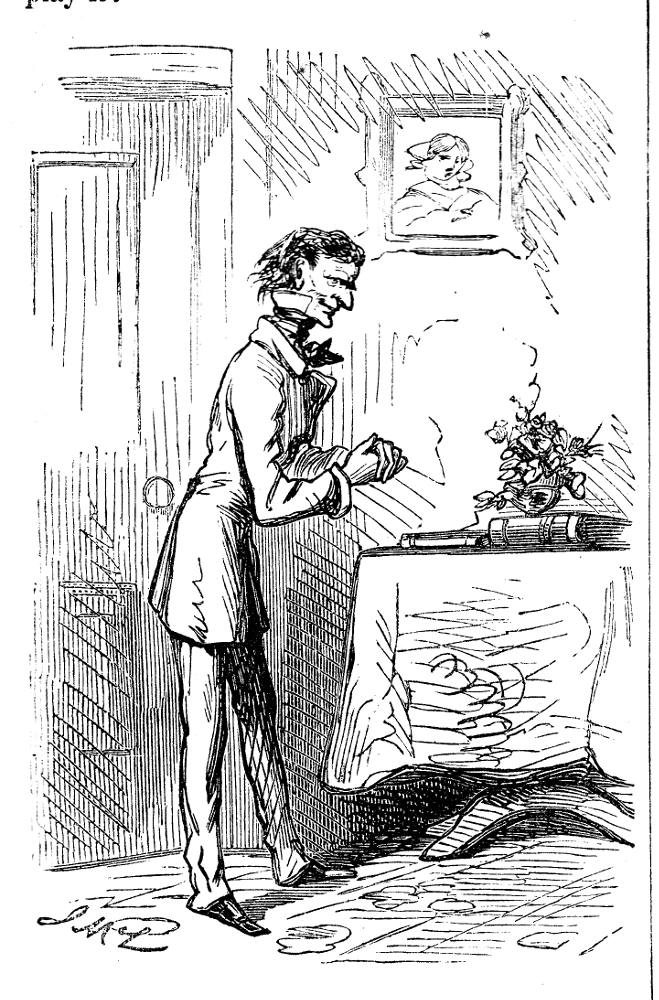

“A mystery in his own house, under his own nose! What did it mean!” Wood-engraving 11.6 cm high by 11.5 cm wide, or 4 ½ inches square, framed, for instalment twenty-five in the American serialisation of Wilkie Collins’s No Name in Harper’s Weekly [Vol. VI. — No. 293] Number 25, “The Fourth Scene — Aldborough, Suffolk.” Chapter VI (page 554; p. 159 in volume), plus an uncaptioned vignettte of Captain Wragge in his parlour at North Shingles Villa, awaiting the social call of Noel Vanstone (page 554; p. 159 in volume): 11 cm high by 5.6 cm wide, or 4 ¼ inches high by 2 ¼ inches wide, vignetted. [Instalment No. 25 ends in the American serialisation on page 555, at the end of Chapter VI. Precisely the same number without illustration ran on 30 August 1862 in All the Year Round.]
Vignette Illustration: Wragge’s Awaiting the Social Call of Noel Vanstone
“I never contradict a lady, ma’am,” rejoined the incorrigible captain. “If it is your pleasure, when we next meet to think my niece quite well, I shall bow resignedly to the expression of your opinion.” With those words, he followed the housekeeper into the passage, and politely opened the door for her. “I mark the trick, ma’am!” he said to himself, as he closed it again. “The trump-card in your hand is a sight of my niece, and I’ll take care you don’t play it!”
He returned to the parlor, and composedly awaited the next event which was likely to happen — a visit from Mrs. Lecount’s master. In less than an hour results justified Captain Wragge’s anticipations, and Noel Vanstone walked in.
“My dear sir!” cried the captain, cordially seizing his visitor’s reluctant hand, “I know what you have come for. Mrs. Lecount has told you of her visit here, and has no doubt declared that my niece’s illness is a mere subterfuge. [“The Fourth Scene — Aldborough, Suffolk.” Chapter VI: in the American serialisation, p. 555; p. 157 in volume]
Main Illustration: Noel Vanstone’s Puzzlement at Mrs. Lecount’s Behaviour
“I have a strange fancy of my own, sir, about that young lady,” proceeded Mrs. Lecount. “If you will excuse my fancy, and indulge it, you will do me a favor for which I shall be very grateful.”
“A fancy?” repeated her master, in growing surprise. “What fancy?”
“Only this, sir,” said Mrs. Lecount.
She took from one of the neat little pockets of her apron a morsel of note-paper, carefully folded into the smallest possible compass, and respectfully placed it in Noel Vanstone’s hands.
“If you are willing to oblige an old and faithful servant, Mr. Noel,” she said, in a very quiet and very impressive manner, “you will kindly put that morsel of paper into your waistcoat pocket; you will open and read it, for the first time, when you are next in Miss Bygrave’s company; and you will say nothing of what has now passed between us to any living creature, from this time to that. I promise to explain my strange request, sir, when you have done what I ask, and when your next interview with Miss Bygrave has come to an end.”
She courtesied with her best grace, and quietly left the room.
Noel Vanstone looked from the folded paper to the door, and from the door back to the folded paper, in unutterable astonishment. A mystery in his own house! under his own nose! What did it mean? [“The Fourth Scene — Aldborough, Suffolk.” Chapter VI: in the American serialisation, p. 555; p. 159 in volume]
Commentary: Wragge’s Cat-and-Mouse Game with Mrs. Lecount over Noel Vanstone
Noel Vanstone is the prize, or, more accurately, his affections and loyalty are the objects of the devious adversaries, Captain Wragge, operating under the pseudonym “Bygrave,” and the Swiss housekeeper, Mrs. Le Count. Unknown to Wragge, from Miss Harriet Garth directly Mrs. Lecount has obtained evidence that she had never visited Noel Vanstone at Vauxhall Court; and she holds in readiness as evidence of Magdalen’s having adopted that disguise a piece of spurious Miss Garth’s dress. But the housekeeper has not bargained on Wragge’s persuading Noel Vanstone to send her away. Thus, the opening vignette focuses on Wragge’s strategizing: having just dealt with the housekeeper, he momentarily expects her employer to pay a social call, enquiring after his niece’s health. But now in the main illustration comes Mrs. Lecount’s brilliant counter-stroke to expose both of Bygraves as frauds.
As Mrs. Lecount flounces out of the room (right), her stunned employer stares at the folded note that she has just given him: he, like the reader, wonders what it contains. Collins does not make the reader wait long: “The folded paper contained nothing less than a carefully written extract from the personal description of Magdalen in Miss Garth’s letter.” Thus, at the very curtain of the twenty-fifth instalment, Mrs. Lecount seems to have exposed the conspiracy against her master. But will the stunned Noel Vanstone, now very much in love with Magdalen (“Susan Bygrave”) credit the note?
Image scans and text by Philip V. Allingham. [You may use the images without prior permission for any scholarly or educational purpose as long as you (1) credit the person who scanned them and (2) link your document to this URL in a web document or cite the Victorian Web in a print one.]
Bibliography
Blain, Virginia. “Introduction” and “Explanatory Notes” to Wilkie Collins's No Name. Oxford World's Classics. Oxford: Oxford University Press, 1986.